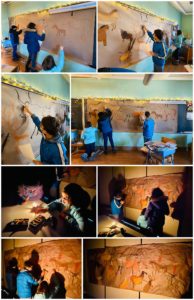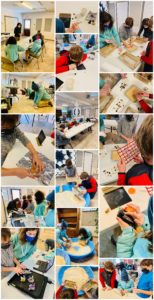In Waldorf education, we use a very experiential approach to Science. A hands-on, multi-faceted approach allows all students to meaningfully engage and connect with their learning: Artistic elements, creative writing, and field trips are combined with visual, audible, and tactile lessons to bring science to life.
This month, our 6th Grade dove into Geology and Mineralogy, and what an experience they had!
The classroom is full of volcano paintings, felted layers of the earth, fossils, crystals and rocks, and hand-made cave drawings. Imagine the students’ enthusiasm as they partook in the following work: As they learned about the interior of our earth, they wet felted layered models of the Earth. As they learned about Plate Tectonics, they used graham crackers and cool whip to model the different plate boundaries, and what changes in the Earth’s crust they create. (Fun, messy, AND delicious!) As they studied the characteristics of volcanoes, they free-painted their own volcanoes during an Artistic period.
The class then explored the world of rocks and minerals. They started off by bridging their Roman History block (from earlier in the school year) with their study of volcanoes by learning about Mt. Vesuvius, the volatile composite volcano in Italy, and its infamous eruption during Roman times that destroyed, covered, and preserved the city of Pompeii in 79 CE.
They then learned about what rocks and minerals are, where they’re found, and all the different ways we use them. Thanks to the school collection and the generously donated samples from the geology lab at HACC, (from a class parent), they had a stellar display of all different types of rocks, minerals, and fossils to explore.
Next, they studied the rock cycle and how different types of rock are created, destroyed, and recycled into new types of rock. To demonstrate this cycle, they used Starburst candies cut into small pieces and squished them together to create sedimentary rocks, added a little heat AND pressure to mold them into metamorphic rocks, and melted and cooled them to make igneous rocks.
They wrapped up the block by learning about the properties of minerals and how to identify them, discussed mineral crystals, and made some beautiful drawings of mineral crystal clusters on black cardstock using chalk pastels.
To round out the classroom experiences, class teacher Summer Tucker scheduled a field trip, a guest speaker, and tied in Language Arts as well as a creative artistic project- bringing all of their new learning to live.
After hearing about limestone caves and how they are formed, they visited Indian Echo Caverns, a local limestone cave system. Over the course of the day, they attended 3 private, hands-on workshops, (Rockin’ Rocks, Fossils Forever, Mineral Madness), and had a 1-hour private cavern tour.
A class parent presented beautiful mineral crystal samples and shared many interesting stories of how she unearthed these crystals from different areas all around the country. She also generously gifted each student with a canvas and small bag of crystals, which they used to make their own beautiful crystal grid artwork.
Students created a diary entry from the first-person perspective of someone living through the eruption of Mt. Vesuvius, as part of their language arts and creative writing work.
Finally, during the scheduled artistic time, they learned about Lascaux Cave in France, an ancient limestone cave covered with prehistoric cave paintings, which was accidentally discovered by 4 teenage boys in the 1940s. After hearing the story, and taking a virtual tour through a replica of the cave, they created their own version of the cave paintings by working together to make a 12ft cave art mural (going as far as hanging it behind the stage and painting by candlelight).
Well done 6th grade. What a fun, informative, and creative Geology Block you’ve had!




